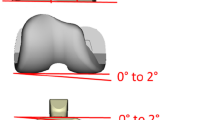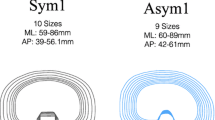Abstract
Purpose
As the correct rotational and sagittal alignment of the tibial tray are of key importance for optimal total knee arthroplasty (TKA) function, the objective of this study was to determine these individual variations in the proximal tibial geometry in terms of posterior tibial slope (PTS) and tibial surface asymmetry by analysing a large dataset of computer tomography (CT) information.
Methods
A retrospective two-part review was performed on 15,807 datasets that were generated during the design phase for a customized TKA implant. First, 15807 CAD (computer-aided-design) models derived from CT data were used to conduct the analysis on the variation of the PTS. Second, the axial cut of each proximal tibia in a consecutively selected subset of 2202 datasets was used to measure the tibial asymmetry.
Results
The majority (65.5%) of tibiae had a posterior slope between 5° and 10°, while 26.5% of knees had a slope > 10°. The asymmetry measured as offset between the lateral and medial posterior boundaries was highly variable, with overall an increasing proportion of patients with high asymmetry with increasing tibial ML width. Only 14% of tibiae exhibited symmetric (< 2 mm offset) lateral and medial plateaus, and 22% had an offset > 5 mm.
Conclusion
This study from an extraordinary large data base reveals that tibial posterior slope and asymmetry of the tibial profile vary largely between patients receiving TKA with increasing tibial asymmetry with ML width. CT scans might help to preoperatively better select the best fitting TKA, otherwise surgeons intraoperatively will often have to deal with compromises regarding fitting, sizing and rotational issues.
Level of evidence
Retrospective case series, Level IV.




Similar content being viewed by others
References
Barrack RL, Schrader T, Bertot AJ, Wolfe MW, Myers L (2001) Component rotation and anterior knee pain after total knee arthroplasty. Clin Orthop Relat Res 392:46–55
Bellemans J, Robijns F, Duerinckx J, Banks S, Vandenneucker H (2005) The influence of tibial slope on maximal flexion after total knee arthroplasty. Knee Surg Sports Traumatol Arthrosc 13:193–196
Bonnin MP, Schmidt A, Basiglini L, Bossard N, Dantony E (2013) Mediolateral oversizing influences pain, function, and flexion after TKA. Knee Surg Sports Traumatol Arthrosc 21:2314–2324
Bourne RB, Chesworth BM, Davis AM, Mahomed NN, Charron KD (2010) Patient satisfaction after total knee arthroplasty: who is satisfied and who is not? Clin Orthop Relat Res 468:57–63
Carpenter DP, Holmberg RR, Quartulli MJ, Barnes CL (2014) Tibial plateau coverage in UKA: a comparison of patient specific and off-the-shelf implants. J Arthroplasty 29:1694–1698
Cheng FB, Ji XF, Lai Y, Feng JC, Zheng WX, Sun YF et al (2009) Three dimensional morphometry of the knee to design the total knee arthroplasty for Chinese population. Knee 16:341–347
Cobb JP, Dixon H, Dandachli W, Iranpour F (2008) The anatomical tibial axis: reliable rotational orientation in knee replacement. J Bone Jt Surg Br 90:1032–1038
Dai Y, Bischoff JE (2013) Comprehensive assessment of tibial plateau morphology in total knee arthroplasty: influence of shape and size on anthropometric variability. J Orthop Res 31:1643–1652
Giffin JR, Stabile KJ, Zantop T, Vogrin TM, Woo SL, Harner CD (2007) Importance of tibial slope for stability of the posterior cruciate ligament deficient knee. Am J Sports Med 35:1443–1449
Hess S, Moser LB, Amsler F, Behrend H, Hirschmann MT (2019) Highly variable coronal tibial and femoral alignment in osteoarthritic knees: a systematic review. Knee Surg Sports Traumatol Arthrosc 27:1368–1377
Hirschmann MT, Friederich NF, Becker R, Karlsson J (2019) Personalised medicine in knee arthroplasty: we need more science! Knee Surg Sports Traumatol Arthrosc 27:1357–1358
Hirschmann MT, Moser LB, Amsler F, Behrend H, Leclerq V, Hess S (2019) Functional knee phenotypes: a novel classification for phenotyping the coronal lower limb alignment based on the native alignment in young non-osteoarthritic patients. Knee Surg Sports Traumatol Arthrosc 27:1394–1402
Hitt K, Shurman JR, Greene K, McCarthy J, Moskal J, Hoeman T et al (2003) Anthropometric measurements of the human knee: correlation to the sizing of current knee arthroplasty systems. J Bone Joint Surg Am 85-A(Suppl 4):115–122
Ho JPY, Merican AM, Hashim MS, Abbas AA, Chan CK, Mohamad JA (2017) Three-dimensional computed tomography analysis of the posterior tibial slope in 100 knees. J Arthroplasty 32:3176–3183
Jojima H, Whiteside LA, Ogata K (2004) Effect of tibial slope or posterior cruciate ligament release on knee kinematics. Clin Orthop Relat Res 426:194–198
Kwak DS, Surendran S, Pengatteeri YH, Park SE, Choi KN, Gopinathan P et al (2007) Morphometry of the proximal tibia to design the tibial component of total knee arthroplasty for the Korean population. Knee 14:295–300
Martin S, Saurez A, Ismaily S, Ashfaq K, Noble P, Incavo SJ (2014) Maximizing tibial coverage is detrimental to proper rotational alignment. Clin Orthop Relat Res 472:121–125
Meier M, Zingde S, Steinert A, Kurtz W, Koeck F, Beckmann J (2019) What is the possible impact of high variability of distal femoral geometry on TKA? A CT data analysis of 24,042 knees. Clin Orthop Relat Res 477:561–570
Meric G, Gracitelli GC, Aram L, Swank M, Bugbee WD (2015) Tibial slope is highly variable in patients undergoing primary total knee arthroplasty: analysis of 13,546 computed tomography scans. J Arthroplasty 30:1228–1232
Moser LB, Hess S, Amsler F, Behrend H, Hirschmann MT (2019) Native non-osteoarthritic knees have a highly variable coronal alignment: a systematic review. Knee Surg Sports Traumatol Arthrosc 27:1359–1367
Noble PC, Conditt MA, Cook KF, Mathis KB (2006) The John Insall award: patient expectations affect satisfaction with total knee arthroplasty. Clin Orthop Relat Res 452:35–43
Nunley RM, Nam D, Johnson SR, Barnes CL (2014) Extreme variability in posterior slope of the proximal tibia: measurements on 2395 CT scans of patients undergoing UKA? J Arthroplasty 29:1677–1680
Okamoto S, Mizu-uchi H, Okazaki K, Hamai S, Nakahara H, Iwamoto Y (2015) Effect of tibial posterior slope on knee kinematics, quadriceps force, and patellofemoral contact force after posterior-stabilized total knee arthroplasty. J Arthroplasty 30:1439–1443
Schroeder L, Martin G (2019) In vivo tibial fit and rotational analysis of a customized, patient-specific TKA versus off-the-shelf TKA. J Knee Surg 32:499–505
Shelburne KB, Kim HJ, Sterett WI, Pandy MG (2011) Effect of posterior tibial slope on knee biomechanics during functional activity. J Orthop Res 29:223–231
Yoshioka Y, Siu DW, Scudamore RA, Cooke TD (1989) Tibial anatomy and functional axes. J Orthop Res 7:132–137
Funding
This study received no funding.
Author information
Authors and Affiliations
Corresponding author
Ethics declarations
Conflict of interest
One of the authors (SZ) is an employee of Conformis Inc (Billerica, MA, USA) and received compensations between 100,000 and 1,000,000. He also received stock values between 10,000 and 100,000. One of the authors (LS) received an intern research scholarship from Conformis Inc. One of the authors certifies that he (AS) has received personal fees for consultant teaching, during the study period, in an amount of less than USD 10,000 from Conformis Inc (Billerica, MA, USA), outside the submitted manuscript. One of the authors certifies that he (JB) has received personal fees for consultant teaching, during the study period, in an amount of less than USD 10,000, from Smith & Nephew (Smith & Nephew GmbH, Hamburg, Germany), Conformis Inc (Billerica, MA, USA) and DePuy Synthes (Umkirch, Germany), all outside the submitted manuscript.
Ethical approval
Since the present study is based on analysing anonymised CT data, IRB approval was not required. Any information that could identify patients was not used in the analysis. Investigators and Statistician dealt with anonymised data only. All procedures performed were in accordance with the ethical standards of the institutional and/or national research committee and with the 1964. Declaration of Helsinki and its later amendments or comparable ethical standards.
Informed consent
Every patient involved agreed by giving informed consent.
Additional information
Publisher's Note
Springer Nature remains neutral with regard to jurisdictional claims in published maps and institutional affiliations.
Johannes Beckmann and Andre Friedrich Steinert share senior authorship.
Rights and permissions
About this article
Cite this article
Meier, M., Zingde, S., Best, R. et al. High variability of proximal tibial asymmetry and slope: a CT data analysis of 15,807 osteoarthritic knees before TKA. Knee Surg Sports Traumatol Arthrosc 28, 1105–1112 (2020). https://doi.org/10.1007/s00167-019-05728-4
Received:
Accepted:
Published:
Issue Date:
DOI: https://doi.org/10.1007/s00167-019-05728-4




